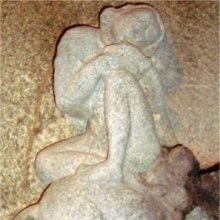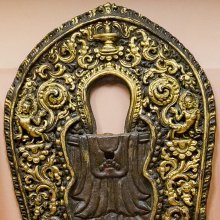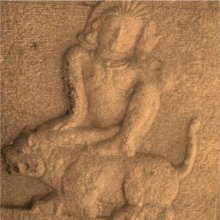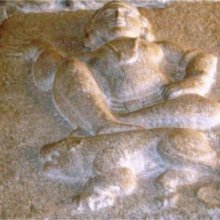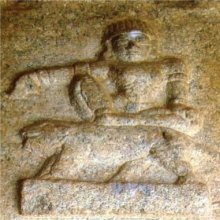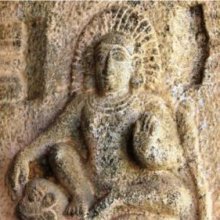Gorakshanatha, Gorakṣanātha, Gorakhanātha, Gorakhnāth, Goraksha-natha, Gorakhnath, Gorakhanatha, Gorakha-natha: 7 definitions
Introduction:
Gorakshanatha means something in Hinduism, Sanskrit, the history of ancient India. If you want to know the exact meaning, history, etymology or English translation of this term then check out the descriptions on this page. Add your comment or reference to a book if you want to contribute to this summary article.
The Sanskrit term Gorakṣanātha can be transliterated into English as Goraksanatha or Gorakshanatha, using the IAST transliteration scheme (?).
Images (photo gallery)
(+9 more images available)
In Hinduism
Shilpashastra (iconography)
Source: DSpace at Pondicherry: Siddha Cult in Tamilnadu (sculpture)Gorakṣanātha (गोरक्षनाथ) refers to the third representation of the nine navanātha reliefs in the Ulsūr Someśvara temple.—The last yogi, after Varāhanātha, is Gorakṣanātha seated on a tiger. His head is tilted downward and resting on his hands which are resting on his folded right knee. His left leg is folded and resting on the tiger. He is wearing the kuṇḍalas and rings on his wrists. A round wallet is also visible on his left arm.
In the Ulsūr Someśvara temple, on the south wall of the ardhamaṇḍapa, there found depictions of the navanāthas (eg. Gorakṣanātha) in a variety of poses with huge coffiures, holding attributes such as kamaṇḍala, daṇḍa (staff) and so on. From east to west the nine sculptures of the Nāthas appear in the following order: seated respectively on a Tortoise, Vyāli, Lion, Fish, Scorpion, Snake, Antelope, Boar and Tiger.

Shilpashastra (शिल्पशास्त्र, śilpaśāstra) represents the ancient Indian science (shastra) of creative arts (shilpa) such as sculpture, iconography and painting. Closely related to Vastushastra (architecture), they often share the same literature.
Shaivism (Shaiva philosophy)
Source: DSpace at Pondicherry: Siddha Cult in Tamilnadu (shaivism)Gorakṣanātha (गोरक्षनाथ) is considered to be the second guru of the Nātha-yoga cult. He is described as Paramahaṃsa. The invention of the Haṭha yoga system is ascribed to him and he is also credited with the foundation of the Kānphaṭa order of yogis, known as Gorakṣanāthis. Gorakṣanātha is considered to be the first disciple of Matsyendranātha. It is also said that Matsyendranātha gave birth to Gorakṣanātha.

Shaiva (शैव, śaiva) or Shaivism (śaivism) represents a tradition of Hinduism worshiping Shiva as the supreme being. Closely related to Shaktism, Shaiva literature includes a range of scriptures, including Tantras, while the root of this tradition may be traced back to the ancient Vedas.
Yoga (school of philosophy)
Source: academia.edu: Tessitori Collection I (yoga)Gorakhnāth is the author of the Aṣṭaparīkṣā, which is included in the collection of manuscripts at the ‘Vincenzo Joppi’ library, collected by Luigi Pio Tessitori during his visit to Rajasthan between 1914 and 1919.—The colophon of the ms. gives Gorakhnāth as the author of the eight tests, but the Gorakhbānī edition places it in an appendix collecting works of other Yogis.—(Cf. Gorakhabodha)—[...] The geographical origin of Gorakhnāth is not clearly known but his thought and teachings have circulated in Rajasthan, and some authors concluded on the basis of the language that he was born in Rajputana.
Source: ORA: Amanaska (king of all yogas): A Critical Edition and Annotated Translation by Jason Birch1) Gorakṣanātha (गोरक्षनाथ) refers to a possible author of the Amanaska Yoga treatise dealing with topics as absorption (laya), yogic powers (siddhi) and liberation, presented in the form of a dialogue between Īśvara and Vāmadeva.—In the first critical edition of the Amanaska, Yognāth Swāmī made the claim that Gorakṣanātha was the author. [...] However, the occurrences of the terms amanaska and anusandhāna are rare in many of the texts he attributes to Gorakṣanātha and so, his claim that Gorakṣanātha wrote the Amanaska is most probably based on secondary sources such as Hazariprasad Dvivedi’s book and the prevalence of references to Samādhi (and not amanaska and anusandhāna) in the texts he cites.
In India today, Gorakṣanātha is generally regarded as the founder of Haṭhayoga and there is textual evidence which seems to support this. For example, the Śārṅgadharapaddhati (4372a-b) presented two types of Haṭhayoga, one of which had six auxiliaries along with Mudrās and Bandhas, and was mastered by Gorakṣanātha, and in the Haṭhapradīpikā (1.4a-b), Svātmārāma confirmed that Matysendra, Gorakṣa and others knew the science of the Haṭhayoga.
2) Gorakṣanātha (गोरक्षनाथ) is the author of the Amaraughaprabodha: a short 13th century treatise on Yoga attributed to Gorakṣanātha which teaches the fourfold system of yoga (Mantra, Laya, Haṭha and Rāja).—Accordingly, “Gorakṣa, who abides constantly in the state of Samādhi, taught Mantra, Laya and Haṭhayoga for the sole purpose of attaining Rājayoga”.
3) The Gorakhnath Mandir, in Gorakhpur, is generally considered to be the headquarters of the Nāth Sect.

Yoga is originally considered a branch of Hindu philosophy (astika), but both ancient and modern Yoga combine the physical, mental and spiritual. Yoga teaches various physical techniques also known as āsanas (postures), used for various purposes (eg., meditation, contemplation, relaxation).
India history and geography
Source: Google Books: Manthanabhairavatantram (history)Gorakhanātha (गोरखनाथ) was the disciple of Matsyendra.—Gorakhnātha probably lived in the 13th century and so post-dates Matsyendranātha who appears in the Sanskrit sources by not less than four centuries. Relating them was a way of linking the Nātha cult founded by Gorakhanātha with the earlier Kaula traditions with which it has much in common. The legend of Matsyendranātha and how he brought the Kaula Tantras into the world narrated in the Kaulajñānanirṇaya is typical of the earlier Kaula traditions that preceded Gorakhanātha.

The history of India traces the identification of countries, villages, towns and other regions of India, as well as mythology, zoology, royal dynasties, rulers, tribes, local festivities and traditions and regional languages. Ancient India enjoyed religious freedom and encourages the path of Dharma, a concept common to Buddhism, Hinduism, and Jainism.
Languages of India and abroad
Sanskrit dictionary
Source: Cologne Digital Sanskrit Dictionaries: Aufrecht Catalogus CatalogorumGorakṣanātha (गोरक्षनाथ) as mentioned in Aufrecht’s Catalogus Catalogorum:—pupil of Mīnanātha: Gorakṣaśataka, called also Jñānaśataka, Jñānaprakāśaśataka. Caturaśītyāsana. Rādh. 17. Jñānāmṛta, yoga. Hall. p. 15. NW. 286. 316. Yogacintāmaṇi. Kāśīn. 30. Bhr. 220. Yogamahiman. NW. 414. Yogamārtaṇḍa. Burnell. 112^b. Yogasiddhāntapaddhati. B. 4, 4. Vivekamārtaṇḍa, yoga. Rādh. 17. Siddhasiddhāntapaddhati. K. 134.
Source: Cologne Digital Sanskrit Dictionaries: Monier-Williams Sanskrit-English DictionaryGorakṣanātha (गोरक्षनाथ):—[=go-rakṣa-nātha] [from go-rakṣa > go] m. Name of the author of -śataka
Sanskrit, also spelled संस्कृतम् (saṃskṛtam), is an ancient language of India commonly seen as the grandmother of the Indo-European language family (even English!). Closely allied with Prakrit and Pali, Sanskrit is more exhaustive in both grammar and terms and has the most extensive collection of literature in the world, greatly surpassing its sister-languages Greek and Latin.
See also (Relevant definitions)
Partial matches: Goraksha, Natha, Gorakha, Nath.
Full-text (+68): Goraksha, Gorakhadhanda, Natha, Gorakkar, Pheri, Kanaphata-Tya-Ti-Di, Jnanamrita, Gorakshashataka, Siddhasiddhantapaddhati, Vivekamartanda, Yogamahiman, Gorakhbani, Yogamartanda, Hathayoga, Siddhantapaddhati, Yogasiddhantapaddhati, Yogamahima, Minanatha, Sampadakiya, Macchendranatha.
Relevant text
Search found 12 books and stories containing Gorakshanatha, Gorakṣanātha, Gorakhnath, Gorakhnatha, Gorakh-natha, Gorakṣa-nātha, Goraksa-natha, Gorakhanātha, Goraksanatha, Gorakhnātha, Gorakha-nātha, Gorakhnāth, Goraksha-natha, Gorakhnath, Gorakh-nath, Gorakhanatha, Gorakha-natha, Gorakshanath, Goraksanath; (plurals include: Gorakshanathas, Gorakṣanāthas, Gorakhnaths, Gorakhnathas, nathas, nāthas, Gorakhanāthas, Goraksanathas, Gorakhnāthas, Gorakhnāths, naths, Gorakhanathas, Gorakshanaths, Goraksanaths). You can also click to the full overview containing English textual excerpts. Below are direct links for the most relevant articles:
Lakulisha-Pashupata (Philosophy and Practice) (by Geetika Kaw Kher)
Goraksanatha and Natha Sampradaya < [Chapter 2 - Spread and Transition]
Appendix 1 - Some Mystical aspects of the Kashmiri Folktale Akanandun
An insight into Asceticism < [Chapter 3 - The Ritualistic Context]
Lord Jhulelal: An Analytical Study (by Thakkar Harish Gopalji)
Part 30 - Bharatiya Sahityache Nirmate, Gorakshanath < [Chapter 2 - Literature Review]
Atharvaveda and Charaka Samhita (by Laxmi Maji)
Apasmāra (epilepsy) according to Caraka < [Chapter 4 - Diseases and Remedial measures (described in Caraka-saṃhitā)]
3b. Udararoga (Udara disease) in the Caraka-saṃhitā < [Chapter 5 - Diseases and Remedies in Atharvaveda and Caraka-Saṃhitā]
2b. Tuberculosis (Yakṣmā or Rājayakṣmā) in the Caraka-Saṃhita < [Chapter 5 - Diseases and Remedies in Atharvaveda and Caraka-Saṃhitā]
Srila Gurudeva (The Supreme Treasure) (by Swami Bhaktivedanta Madhava Maharaja)
Powerful Grandfather < [Chapter 1.2 - Śrīla Gurudeva’s Pūrvāśrama]
Back to Home Village (Introduction) < [Chapter 1.5 - Back to Home Village]
Birthplace of Śrīla Gurudeva < [Chapter 1.2 - Śrīla Gurudeva’s Pūrvāśrama]
Stupas in Orissa (Study) (by Meenakshi Chauley)
Kalachakrayana (in Tantric Buddhism) < [Chapter 2]
Related products
